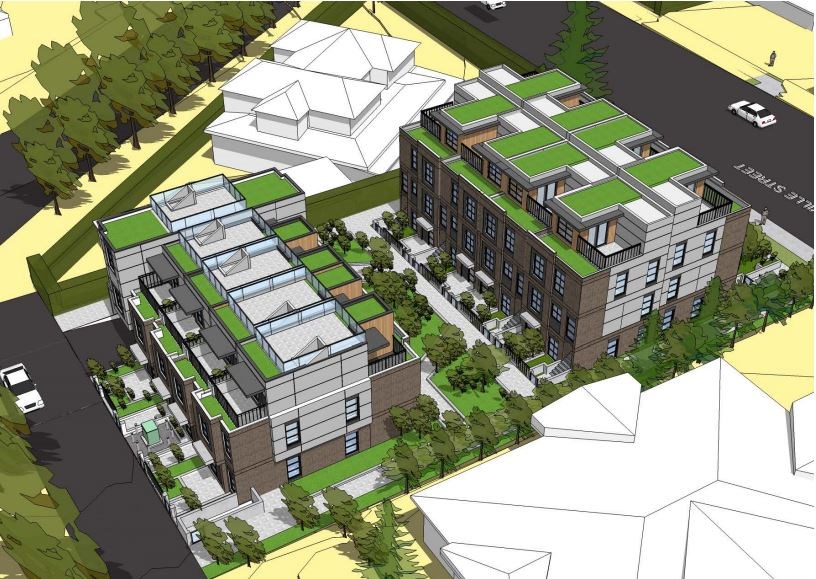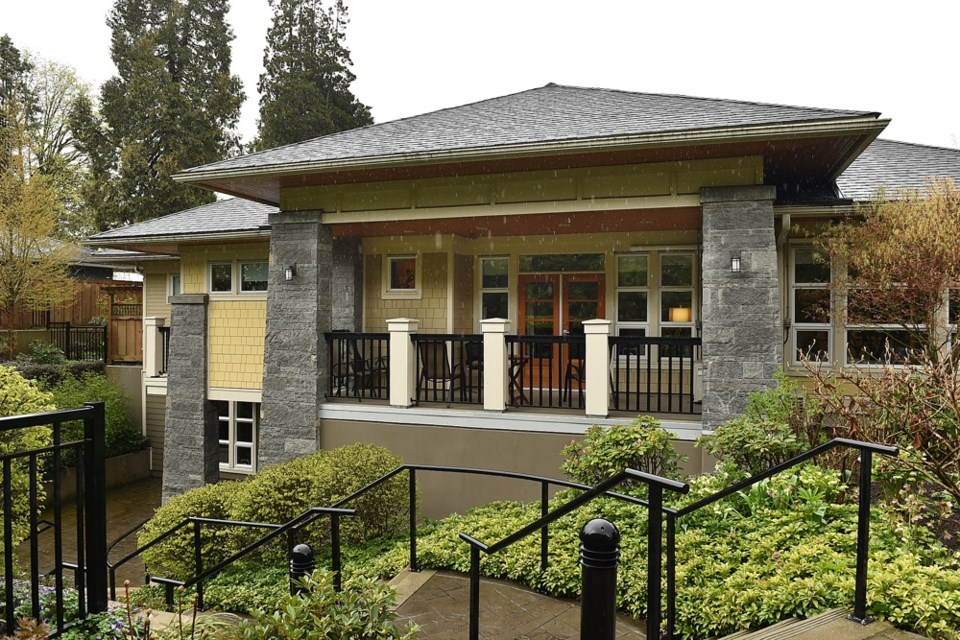The Â鶹´«Ă˝Ół»Hospice Society is continuing its fight against a townhouse development proposed to be built next to its Granville Street location now that the rezoning application for the project has been referred to a June 11 public hearing.
The application, which is being considered under the Affordable Housing Choices Interim Rezoning Policy, envisions two buildings — two-and-a-half storeys and three-and-a-half storeys — that would house 21 secured market rental townhouse units. They would be built on an existing single-family property at 4575 Granville St.
The hospice, located at 4615 Granville St., is beside it. The facility opened in 2014. Eight patients can be cared for at a time. Their average stay is about three weeks before they die. About 175 patients pass away at the hospice annually.
Â鶹´«Ă˝Ół»Hospice Society executive director Simin Tabrizi maintains the development, at its proposed height and density, is incompatible with the hospice.
“The living have rights, but the dying have rights, too,” she said. “A small place that was built to accommodate the dying in Â鶹´«Ă˝Ół»is going to be completely negatively affected by this development. I don’t know why that is not falling on right ears. I don’t know why the city feels that that’s of minimum concern.”

Tabrizi maintains the construction phase would be disruptive to those who are dying and their families, the buildings are too tall and, once built, would compromise patients’ privacy, and the project is too dense. She anticipates it could accommodate as many as 92 residents.
The hospice’s patients, according to Tabrizi, need the serenity and privacy currently afforded to them at the facility.
She’s not satisfied with changes made to the development in response to feedback.
“The proposal, in essence, has not really changed in any way that would address the concerns that we have,” she told the Courier.
Tabrizi also said the May 14 staff report to council about the project featured “omissions or inaccuracies,” including the number of people who signed the petition against the development.
The report cited 200 signatures, while Tabrizi said there were 3,000 signatures, along with another online petition with 5,500 signatures.
The hospice society believes the staff report downplayed opposition and didn’t highlight “the adverse effects the proposed development would have on the community…”
The society further argues that the application isn’t consistent with the intent of the Affordable Housing Choices Interim Rezoning Policy because it “expressly requires that a degree of public support be demonstrated,” which the society maintains isn’t the case.
“Basically, we are arguing that this is a community resource that was built by community members and that the city didn’t take the time to consider the fact that it’s a hospice next door, which is of value to the citizens of Â鶹´«Ă˝Ół»that it serves,” Tabrizi said.
“A development of this nature can go anywhere. We understand the city has an interest to densify Granville much along the same lines as Cambie and Oak, and that may be an appropriate thing to do in the city, but there has to be a community plan around that so that we can state our case more clearly. At the very least, any developments that are adjacent to the hospice ought to be more organically related to this service.”
She added that there are no similar housing projects within 15 blocks in either direction of the site and that it’s not near shopping or other community amenities.
City of Â鶹´«Ă˝Ół»staff met with the Â鶹´«Ă˝Ół»Hospice Society during the application process and the society’s feedback was incorporated into recommendations that went before council on May 14, according to Karen Hoese, assistant director of the rezoning centre.
She told the Courier via email that changes to the project aimed at addressing concerns included:
- balconies being reoriented so that they no longer directly face the hospice
- privacy screening added to balconies and private outdoor spaces
- quiet zone proposed for the area of property directly next to the hospice by moving the parking ramp and children’s play area to the other side of the property and adding landscaping in a three to 4.6 metre wide strip zone along the property line next to the hospice
- more underground parking to avoid impact of street parking
- underground parking ramp moved to reduce the impact on hospice operations
- the applicant has also expressed a desire to work with hospice to minimize construction impacts.
Hoese said a correction is being made to the number of people who signed the petition against the development. The 200 count is being changed to 598.
However, the online petition wasn’t submitted during the consultation process so it was not counted in the city’s public feedback review that went before council.
Reaction to the project was mixed, according to Hoese, with 215 written comment sheets submitted during the open house and 138 pieces of correspondence via letters, emails, online comments and other input.
“It is important to note that there is some duplication of responses as city staff receive comments through a number of mediums,” she wrote. “As such, staff focus on qualitative theming of comments (included in Appendix D) rather than percentages [of support and opposition].”
W. Neil Robertson of Stuart Howard Architects, who designed the housing project, said there are many examples of hospices existing beside midrise and high-density developments.
“I fail to see how it’s necessarily incompatible,” he said. “There’s the hospice out at UBC that was on the news several years ago. They put that in right next to a tower. There’s a whole bunch of hospices that exist in the Downtown Eastside that manage to service their needs adjacent to midrise development, so I really don’t see how it’s especially incompatible [to put] family housing next to a hospice.”
Robertson said he’s had “very cordial conversations” with representatives from the hospice society and neither he, nor his client, harbour any ill will towards them.
“In fact, it’s quite the opposite,” he said. “We want to work with them. I can’t really speak to exactly why they’re so ardently opposed to it except, perhaps, fear of change.”
While he said he understands why the society would be concerned about construction noise, he noted that under current zoning a 12,000-square-foot house could be built on the property.
Robertson called privacy “a reasonable concern,” but said he’s worked with the city planning department to implement measures to alleviate those fears such as by flipping the project to change the driveway location to the opposite side of the site, by moving the kids’ play area as far away from the hospice as possible, and by introducing landscape buffers.
“We’ve committed to them that if they would like to join us, and participate with us in helping to select visual protection that would help alleviate their concerns, we’d be happy to do that,” he said.
Windows on the side of the building overlooking the site would be whited out so that privacy is created while letting in light.
Robertson noted the project also has many supporters, based on input collected at the open house, and he hopes the hospice’s opposition won’t derail the development at the public hearing.
“I think it’s a good project for the community and I hope that council will be able to weigh all the concerns. Their concerns are valid and I understand nobody likes change. I’m very sensitive to that, but that’s the question to council — do we want to put in 21 secured rental, family-oriented [units] or do we want to put in another 12,000-square-foot mansion.”



